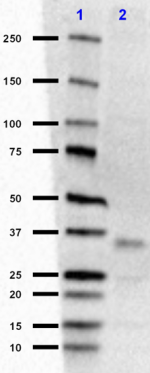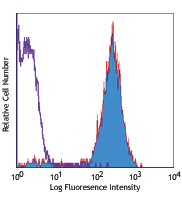- Clone
- E6D7 (See other available formats)
- Regulatory Status
- RUO
- Other Names
- Apolipoprotein E, apolipoprotein E3, AD2, LDLCQ5, LPG, ApoE
- Isotype
- Mouse IgG1, κ
- Ave. Rating
- Submit a Review
- Product Citations
- publications

-

Human PBMC monocytes were cultured overnight with (left) or without (right) 100ng/mL recombinant human TGF-β1 followed by a 4 hour addition of 1X Brefeldin A (left) or DMSO (right). Cells were then fixed with Fixation Buffer (BioLegend Cat. No. 420801) and permeabilzed with Intracellular Staining Permeabilization Wash Buffer (10X) (BioLegend Cat. No. 421002). Cells were stained with CD11b (clone ICRF44) APC and anti-ApoE Antibody (clone E6D7) PE.
| Cat # | Size | Price | Save |
|---|---|---|---|
| 803404 | 25 tests | ¥33,660 | |
| 803405 | 100 tests | ¥79,200 |
Apo-E is a class of apolipoprotein primarily synthesized in the liver, but is also found in other tissues such as brain, kidneys, and spleen. Apo-E is a protein component of serum chylomicron and lipoprotein particles, playing essential roles in cholesterol transportation, homeostasis, and metabolism. The expression of Apo-E is induced by cholesterol-rich diets and hyperlipoproteinemia. In the central nervous system, Apo-E is produced by astrocytes and microglia. The Apo-E-containing lipoprotein particles play important functions in brain injury repair, neurogenesis, and synaptic plasticity. Apo-E has been found to be involved in the regulation of amyloid-β aggregation and clearance. Genetic polymorphisms of Apo-E are associated with neuron degenerative disorders including Alzheimer's disease.
Product DetailsProduct Details
- Verified Reactivity
- Human
- Antibody Type
- Monoclonal
- Host Species
- Mouse
- Immunogen
- This antibody was raised against a synthetic peptide corresponding to amino acids surrounding the polymorphic amino acid position 158 of Apo-E.
- Formulation
- Phosphate-buffered solution, pH 7.2, containing 0.09% sodium azide and BSA (origin USA)
- Preparation
- The antibody was purified by affinity chromatography and conjugated with PE under optimal conditions.
- Concentration
- Lot-specific (to obtain lot-specific concentration and expiration, please enter the lot number in our Certificate of Analysis online tool.)
- Storage & Handling
- The antibody solution should be stored undiluted between 2°C and 8°C, and protected from prolonged exposure to light. Do not freeze.
- Application
-
ICFC - Quality tested
- Recommended Usage
-
Each lot of this antibody is quality control tested by intracellular immunofluorescent staining with flow cytometric analysis. For flow cytometric staining, the suggested use of this reagent is 5 µl per million cells in 100 µl staining volume or 5 µl per 100 µl of whole blood.
- Excitation Laser
-
Blue Laser (488 nm)
Green Laser (532 nm)/Yellow-Green Laser (561 nm)
- Application Notes
-
This antibody is effective in immunoblotting (WB).
Clone E6D7 recognizes the E2, E3, and E4 isoforms of apolipoprotein E. -
Application References
(PubMed link indicates BioLegend citation) -
- Munoz DG, Feldman H. 2000. CMAJ. 162(1):65-72.
- Hagberg JM, et al. 2000. Physiol Genomics 4(2):101-108.
- Saunders AM. 2000. J. Neuropathol. Exp. Neurol. 59(9):751-8.
- Golabek AA, et al. 2000. Biophys. J. 79(2):1008-15.
- Zunarelli E, et al. 2000. Breast Cancer Res. Treat. 63(3):193-8.
- Zunarelli E, et al. 2000. Clin. Neuropathol. 19(1):1-6.
- Tomiyama T, et al. 1999. Cell Mol. Life Sci. 56(3-4):268-79.
- Golabek AA., et al. 1999. J. Biol. Chem. 271(18):10602-6.
- RRID
-
AB_2801139 (BioLegend Cat. No. 803404)
AB_2801140 (BioLegend Cat. No. 803405)
Antigen Details
- Cell Type
- Astrocytes, Mature Neurons, Microglia, Monocytes, Neurons, Oligodendrocytes
- Biology Area
- Cell Biology, Neurodegeneration, Neuroscience, Neuroscience Cell Markers, Protein Misfolding and Aggregation, Protein Trafficking and Clearance
- Molecular Family
- APP/Aβ Degradation, Apolipoproteins
- Gene ID
- 348 View all products for this Gene ID
- UniProt
- View information about Apo E on UniProt.org
Related FAQs
- What type of PE do you use in your conjugates?
- We use R-PE in our conjugates.
Other Formats
View All Apo E Reagents Request Custom Conjugation| Description | Clone | Applications |
|---|---|---|
| Purified anti-Apo E | E6D7 | WB |
| PE anti-Apo E | E6D7 | ICFC |
| TotalSeq™-C1092 anti-Apo E Antibody | E6D7 | ICPG |
Customers Also Purchased
Compare Data Across All Formats
This data display is provided for general comparisons between formats.
Your actual data may vary due to variations in samples, target cells, instruments and their settings, staining conditions, and other factors.
If you need assistance with selecting the best format contact our expert technical support team.
-
Purified anti-Apo E

Western blot of purified anti-Apo E antibody (clone E6D7). ... 
Western blot of purified anti-Apo E antibody (clone E6D7). ... -
PE anti-Apo E

Human PBMC monocytes were cultured overnight with (left) or ... -
TotalSeq™-C1092 anti-Apo E Antibody
















Follow Us